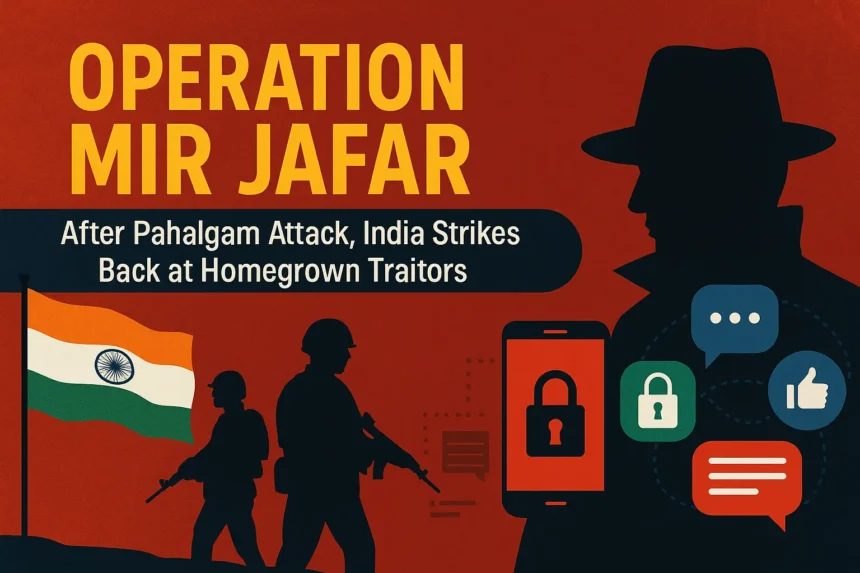Operation Mir Jafar: After Pahalgam Attack, India Strikes Back at Homegrown Traitors
In the wake of the horrifying Pahalgam terror attack, India launched not just a bold cross-border retaliation—Operation Sindoor—but followed it with something far more internal and unsettling: Operation Mir Jafar. This time, the battlefield wasn’t across borders, but within our own soil. The enemy? Hidden in plain sight.
Let’s take a deep dive into this gripping story of betrayal, patriotism, and intelligence brilliance.
What Is Operation Mir Jafar?
Key Details of Operation Mir Jafar
To better understand the scope, intent, and strategic focus of Operation Mir Jafar, the table below highlights its key aspects—from origins to mission objectives.
| Operation Name | Operation Mir Jafar |
|---|---|
| Nature | Classified intelligence-led crackdown |
| Target | Indian citizens suspected of spying for Pakistan’s ISI |
| Objective | Expose and neutralize internal threats to national security |
| Named After | Mir Jafar – infamous historical traitor |
| Background | Launched after Operation Sindoor’s success against terror bases in Pakistan |
| Focus | Internal surveillance, digital espionage, foreign data leaks |
| Method | Intelligence gathering, investigation, and targeted arrests |
Who’s Involved? Arrests Begin
One of the first high-profile arrests under this operation is YouTuber Jyoti Malhotra from Hisar. According to sources, she is accused of sharing sensitive visuals and intelligence data with operatives connected to the ISI.
But she’s not alone.
Reports suggest multiple arrests have already been made, and more are expected as digital trails, mobile records, and financial transactions are being closely scrutinized. Many suspects are from Delhi, Punjab, Haryana, Rajasthan, Uttar Pradesh, Jammu and Kashmir, and other sensitive zones.
How the Spying Worked: A Web of Digital Espionage
This isn’t espionage of the old times with invisible ink and secret couriers. This is 21st-century spying, done with:
- Mobile phones
- Social media networks
- Encrypted messaging apps
- Foreign-funded trips
- Luring money transactions
Indian agencies believe photographs, movement data of military units, and strategic visuals were sent to handlers in Pakistan—sometimes even coordinated from within the Pakistani embassy in New Delhi.
Some individuals were either paid, given travel opportunities, or emotionally manipulated into providing national security-related information.
Why the Name “Mir Jafar”?
The code name is both symbolic and psychological. Mir Jafar is remembered in Indian history as the man who betrayed Bengal to the British. Using this name serves two purposes:
- To instill a sense of shame in those betraying the country.
- To signal to citizens that this is not just a legal operation, but a moral one—fighting against internal traitors.
This powerful naming strategy is also boosting public sentiment, with social media erupting in support of the crackdown and calls for stronger punishment.
What the Investigation Revealed So Far
According to top officials, preliminary evidence reveals:
- Involvement of ISI-linked operatives based in Pakistan’s Delhi embassy
- Use of fake IDs and foreign currency transfers
- Frequent international trips as a cover for recruitment or training
- Videos and images sent directly via Indian mobile devices
- A network of individuals across multiple Indian states
The Indian security apparatus, including RAW, IB, and Military Intelligence, is working in coordination to ensure that no stone is left unturned.
What’s Next? More Arrests Expected
Sources within the agencies confirm that:
- More arrests will follow
- Interrogations are ongoing
- Electronic surveillance is in full force
- Legal proceedings have started in multiple courts
Several suspects are already in judicial custody, and data is being extracted from their digital devices. Authorities are moving with precision, ensuring that all arrests are legally sound and backed by solid evidence.
Public Reactions: Shock, Support, and Demand for Justice
This operation has touched a nerve. On social media platforms like X (formerly Twitter) and Instagram, hashtags like #OperationMirJafar and #NoMercyForTraitors are trending.
People are expressing a mix of shock, anger, and patriotic fervor, demanding strong punishment and even advocating for stricter espionage laws.
There is also a growing demand to scrutinize foreign-funded influencers, vloggers, and content creators—many of whom may unknowingly or knowingly assist in spreading misinformation or sharing sensitive locations.
Why Operation Mir Jafar Matters
This isn’t just another intelligence operation. This is a wake-up call for a digital generation. It shows that:
- Cybersecurity is national security.
- Information, however small, can be lethal in enemy hands.
- Patriotism is about vigilance—not just at the border, but at home.
India is changing its doctrine—from reactive to proactive. From defending to detecting and dismantling threats before they strike.
Final Thoughts: A Nation on Guard
Operation Mir Jafar stands as a powerful reminder that while our brave soldiers guard the borders with unwavering courage, the responsibility of safeguarding the nation from within lies with every citizen. In an age where a single photo, a casual online chat, or a shared data point can be exploited—vigilance is patriotism.
This operation reflects India’s unyielding resolve to defend its sovereignty—not just from external enemies, but from threats hiding in plain sight. It is a call to every Indian: national security is not just a duty of the armed forces, but a shared commitment of every heart that beats for the tricolour.
Want to Stay Updated on National Security and Geopolitics?
Subscribe to TN HEADLINES24 and never miss out on crucial developments like Operation Mir Jafar.
Most read: https://tnheadlines24.com/travel-vlogger-jyoti-malhotra/
Also read: https://tnheadlines24.com/pakistan-uses-social-media-to-spy-on-india/
Disclaimer: The content published on TN HEADLINES24 is for informational purposes only. While efforts have been made to ensure accuracy, TN HEADLINES24 does not assume responsibility for the authenticity of external sources, statements, or claims referenced in this article. Readers are advised to verify facts independently before drawing conclusions.

